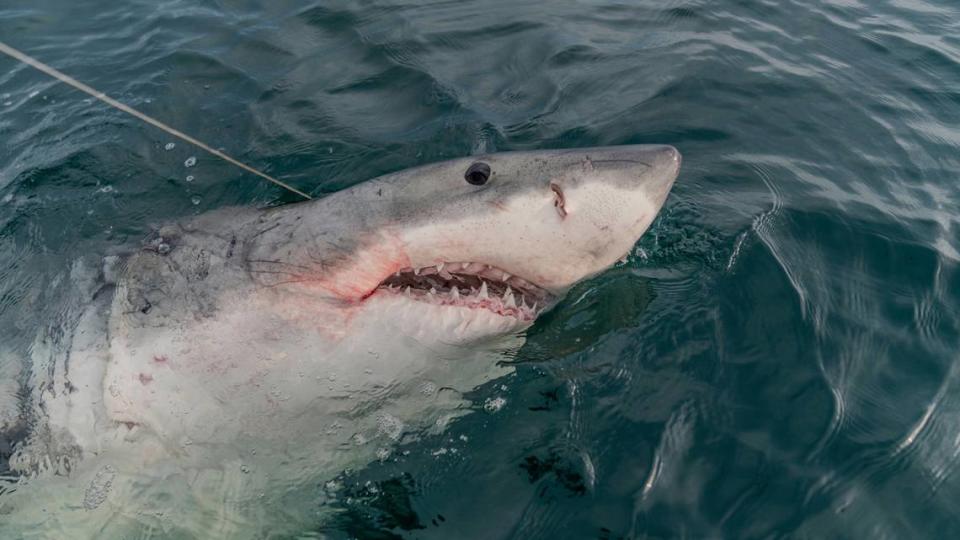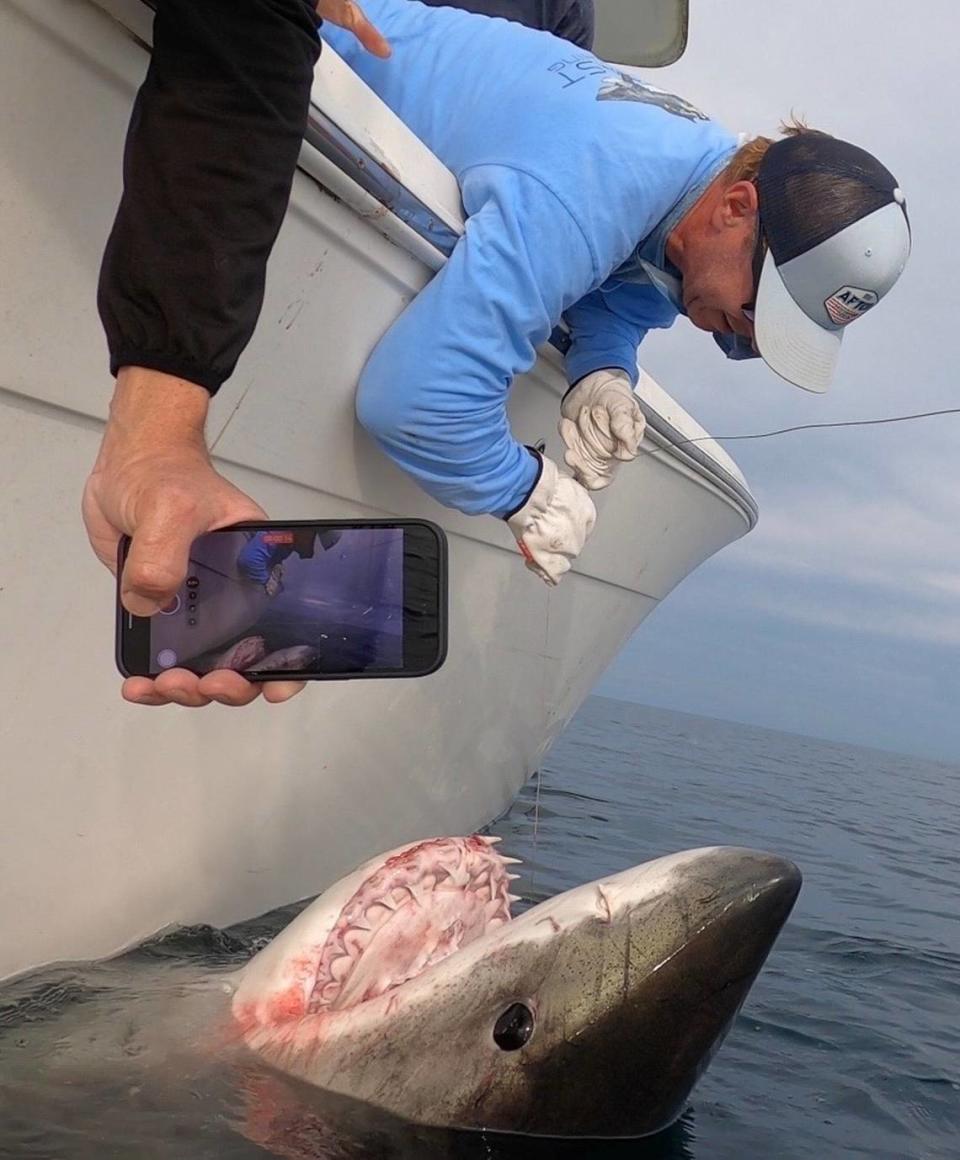Massive shark tagged off Hilton Head will be easier for researchers to track. Here’s why
Megan Winton is on pins and needles and Chip Michalove is having trouble sleeping.
But the massive great white shark reeled in Friday that Michalove and Winton tagged and released off the coast of Hilton Head Island is doing just fine. More than fine, really.
The nearly 3,000 pound, over 14-foot-long apex predator made history Dec. 8 when Winton, a scientist with the Atlantic White Shark Conservancy, and local charter captain Michalove affixed the newest technology to the shark. She’s the first white shark tagged in the Southeast to sport a camera on her dorsal fin to visually show a day in the life. She was also this season’s first white shark catch and release for Michalove.
“I’m over the moon,” Winton said. “Christmas came early for me this year.”
As Winton anxiously awaits the download of a days-worth of data from the camera tag, Michalove is restlessly questioning what the rest of the season holds.
A hearty great white
When Michalove was ready for his first white shark excursion of the season, it was fortuitous that Winton was in the Southeast for the holidays. As is her nature, she had all her equipment ready — including the camera tags.
Winton, Michalove, a photographer and two avid anglers took off Friday morning, running on confidence but not surety of the white shark they’d come across.
When the season begins, Michalove will find white sharks, but they tend to be on the smaller side. But last week, the pattern didn’t hold.
A massive shadow, far larger than normal, swam toward the back of his boat that morning. His heart began racing so rapidly that he felt the beats pulsating all the way to his fingertips.
“I thought I was going to have a heart attack,” said Michalove, who owns Outcast Sport Fishing.
The shark, between 2,600 and 2,800 pounds, initially put up a buffalo-like fight, thrashing her head back and forth. But once her will was broken and she knew her life wasn’t on the line, Michalove called her tag and release a “piece of cake” and the “perfect fight.” As Winton and Michalove applied four tags to the shark, her huge girth rolled calmly in the water with the ease of that like a gentle manatee.

Estimated to be in her mid-to-late 20s, the shark was lashed with seal scars from her pectoral fins up to her nose. Some fresh. Some nearly healed. Notches bore into her gills.
“This is a fish who has seen some things,” Winton said.
Like a fingerprint, the different battle wounds on white sharks helps researchers identify whether they documented the particular fish before. Winton added that it’s likely this shark was up on the coast of Cape Cod over the summer, where white sharks go to feed on seals in shallow waters. When the nasty Northeastern winter chills the seas, they barrel down to the Southeast.
The behemoth shark was given the moniker “LeeBeth” to honor Pastor Ed Young’s daughter who died in 2021 at the age of 34. LeeBeth Young was just as avid an angler as her father and loved shark fishing, Michalove said. Ed Young has been on a handful of Michalove’s fishing trips and was part of the Dec. 8 team.
It was fitting that the first white shark of the season, unexpectedly grand and swimming away with four tags, was named after a woman who respected the mysterious and misunderstood creature.
And leave it to LeeBeth.
The shark was already showing scientists the ropes only days later when she pinged off the coast of Sapelo Island.
What can the tags teach us?
Winton is still processing the pure perfection of LeeBeth’s tagging.
Fastened onto the shark was a pop-off tag that’ll last eight months. Then there’s a spot satellite tag that hangs on for about a year. The acoustic tag stays intact for up to 10 years. The tags give scientists a plethora of data, everything from the species’ preferred water temperatures and saltiness to how many miles the sharks travel.
Similar in size and weight to LeeBeth, and tagged off the coast of Hilton Head in 2017, “Grace” has shown the world her prolific journey. Her namesake honors Grace Sulak, a 14-year-old from Bluffton who was killed in 2016 when a white pickup truck hit the vehicle she was riding in with her best friend and her friend’s mother, running the car off the road and into a tree.
Because of tagging, scientists know that in a 15-month span, Grace made it as far as north of Nova Scotia and way down to southern Florida and its Gulf Coast. If you drew a straight line, she would’ve covered 3,700 miles. But she likely zigged and zagged, covering closer to 5,000.
Typically, larger white sharks can cover more ground, Winton said, and they can take extensive off-shore excursions into the middle of the Atlantic. The older tags are vital in showing those depths and lengths the sharks will go. But the camera tag, the newest technology, is what excites Winton and Michalove most.

Like its name suggests, the camera tag visually records the shark’s movement for a day. About 20 of the tags have been deployed by the conservancy on white sharks swimming in the Cape Cod area. The camera tag records data 20 times a second and also contains a three-dimensional sensor that allows scientists to look at the shark’s movement and behavior.
They’ve witnessed a shark get zapped by a torpedo, others stunned by seals and diving birds, one staring at rocks and buoys, and another relying on the current after eating to push water through its gills instead of constant swimming.
LeeBeth will lead the way for the Southeast.
Once LeeBeth safely and slowly swam away with all the tags secured, Michalove, the photographer and anglers were immediately on cloud nine. Though, it’s keeping Michalove awake at night as he wonders whether the huge start to the season is foreshadowing for more big sharks to come.
Winton shared in the emotional moment, but quickly the differences between fishermen and scientists became clear. As the other four continued hooting and hollering, worry set in for Winton. When the camera tag popped off, would they find it in an Atlantic scavenger hunt?
Michalove and Winton did. About 40 miles off the coast of Georgia.
Once the painfully slow download from the tag is ready, Winton will have to go through it. It’s not a straightforward task. The technology provides millions of data points recorded during the course of the day-long deployment and hours of video footage.
Will the public be able to watch LeeBeth’s day-in-the-life? Absolutely.
“We will probably be screaming it out into the world,” Winton said.
Want to track great white sharks?
The Atlantic White Shark Conservancy and Massachusetts Division of Marine Fisheries’ “White Shark Logbook” is an online catalog of over 600 tagged and untagged individual Northwest Atlantic white sharks. It shows historic acoustic detection data from 2010 to 2022.
For real-time sighting and detection data, head to the free Sharktivity app.

